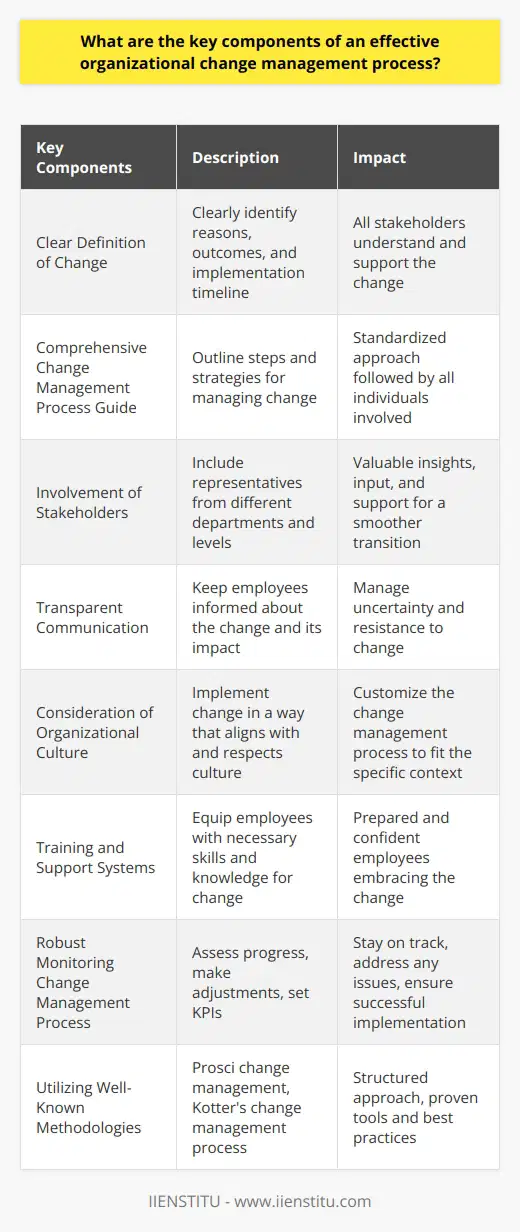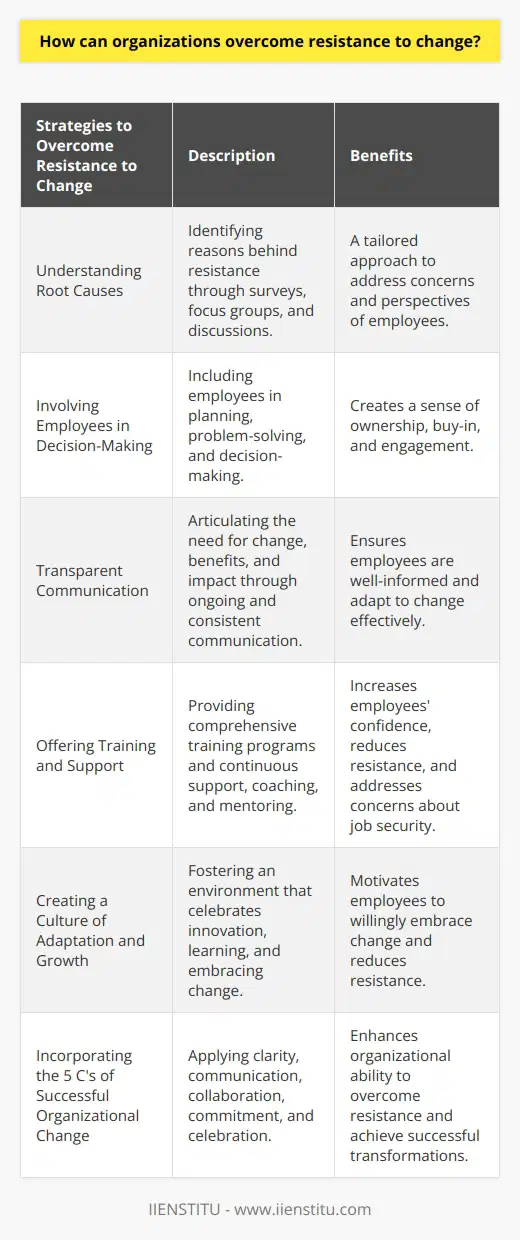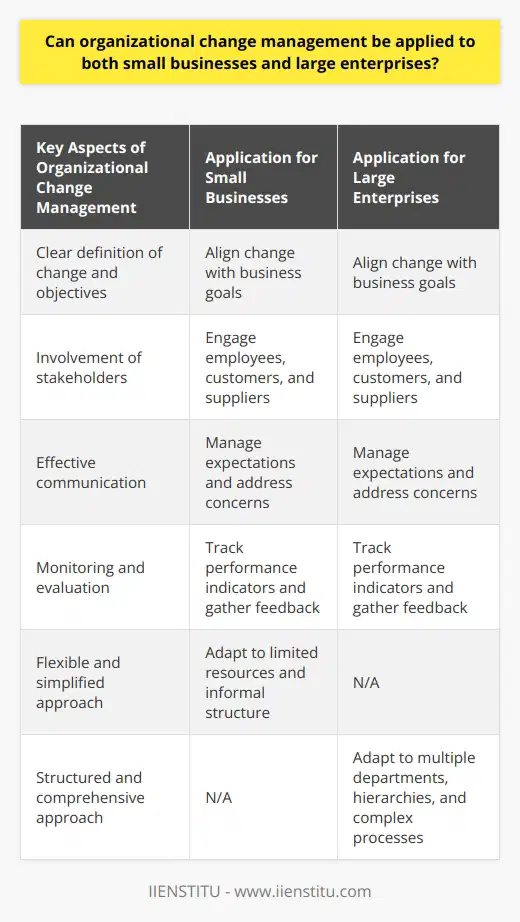
In the dynamic world of modern business, organizational change management (OCM) has emerged as a vital discipline. But what exactly is it, and why has it become so crucial?
Organizational change management is more than a buzzword; it's a comprehensive framework. It's about strategically guiding organizational changes to align with business goals, maximize returns, and minimize negative outcomes. Whether it's implementing new technology, adapting to shifting economic landscapes, or reorganizing the company's structure and culture, OCM plays a pivotal role.
I remember when my company underwent a significant change a few years ago. We were transitioning from a traditional hierarchical structure to a more flat, team-based approach. It was a daunting task, and initially, there was a lot of resistance and confusion among employees. However, our leadership team recognized the importance of effective change management and took a proactive approach.
They started by clearly communicating the reasons behind the change and how it aligned with our long-term goals. They involved employees in the process, seeking their input and addressing their concerns. They also provided extensive training and support to help everyone adapt to the new ways of working. It wasn't an easy journey, but by following organizational change management best practices, we were able to successfully navigate the transition and emerge stronger as a company.

The objective of this guide is to unlock the success factors behind effective organizational change management. We'll delve into the various types of changes an organization may face, explore the key strategies and processes for managing these changes, and provide practical insights to make organizational change management a triumph in your enterprise.
Strategic Changes:
Definition: Strategic changes are alterations made to the core direction or mission of the organization.
Importance: Aligning with long-term goals and market demands.
Example: Rebranding, entering a new market, or adopting a new business model.
Structural Changes:
Definition: Structural changes involve modifications in the organizational hierarchy, departmentalization, or reporting relationships.
Importance: Enhancing efficiency, collaboration, and adaptability.
Example: Merging departments, decentralizing authority, or introducing cross-functional teams.
Technological or Process-Oriented Changes:
Definition: These changes relate to the implementation of new technologies or the optimization of existing processes.
Importance: Improving productivity, quality, and innovation.
Example: Implementing a new CRM system, automating manual tasks, or adopting Lean manufacturing practices.
People-Oriented Changes:
Definition: People-oriented changes focus on the human element of the organization, such as leadership style, corporate culture, or employee development.
Importance: Building a positive work environment, enhancing employee satisfaction, and fostering growth.
Example: Introducing new training programs, shifting to a more participative leadership style, or implementing employee wellness initiatives.
Are you ready to embark on this journey? Whether you're a seasoned manager, a change management professional, or someone interested in enhancing your organizational strategies, this comprehensive guide is designed to provide you with the tools and knowledge you need. Let's begin by understanding the various facets of organizational change management and how they can be applied effectively in today's business environment.
Types of Organizational Change
In any organization, change is not a singular, monolithic concept. It takes many forms and can be driven by various factors. Understanding the different types of change is essential in the process of organizational change management. Let's explore these types in detail:

Strategic Changes
Definition: Strategic changes are alterations made to the core direction or mission of the organization.
Clearly Defining the Change:
Understand what the change entails and why it's necessary.
Align it with business goals and the overall strategic vision.
Outline the expected benefits, challenges, and measurable objectives.
Determining Impacts and Those Affected:
Identify the departments, teams, or individuals impacted by the change.
Assess potential resistance and support.
Develop strategies to engage stakeholders and address concerns.
Developing a Communication Strategy:
Create a comprehensive communication plan.
Ensure transparency and honesty in conveying the change.
Utilize various channels to reach different audience segments.
Crafting a Detailed Change Management Process:
Design a step-by-step change management process that includes preparation, planning, implementation, and review.
Consider using established frameworks like Prosci change management or Kotter change management process.
Include checkpoints for monitoring and adjustments.
Creating a Roadmap and Providing Support:
Outline the timelines, milestones, and success criteria.
Offer training, resources, and continuous support to ease the transition.
Recognize and reward contributions to foster a positive change culture.
Measuring Success and Reflecting:
Evaluate the outcomes against the set objectives.
Gather feedback and reflect on what went well and what could be improved.
Ensure that the changes are embedded within the organization's culture and practices.
Importance: Aligning with long-term goals and market demands.
Example: Rebranding, entering a new market, or adopting a new business model.
One notable example of strategic change is Apple's transition from being primarily a computer company to a consumer electronics and services giant. Under the leadership of Steve Jobs, Apple made bold moves to enter new markets, such as music with the iPod and iTunes, and mobile phones with the iPhone. These strategic changes transformed the company and positioned it for tremendous growth and success (Isaacson, 2011).
Structural Changes
Definition: Structural changes involve modifications in the organizational hierarchy, departmentalization, or reporting relationships.
Importance: Enhancing efficiency, collaboration, and adaptability.

Example: Merging departments, decentralizing authority, or introducing cross-functional teams.
A classic case study of structural changes in organizations is the transformation of General Electric (GE) under the leadership of Jack Welch. Welch introduced a matrix organizational structure, which combined functional and product-based reporting lines. This change fostered greater collaboration, innovation, and customer focus, leading to improved performance and growth (Bartlett & Wozny, 2005).
Understanding Different Change Management Models: There are several well-known change management models that organizations can leverage, each offering a unique perspective on managing change. For example, the Prosci change management model emphasizes individual change as a pathway to organizational success. In contrast, the Kotter change management process focuses on an 8-step approach, starting with creating a sense of urgency and leading through to embedding change. Understanding different models allows organizations to choose or adapt the one that best fits their specific needs, culture, and objectives.
Strategically Planning and Aligning Change: Strategic planning involves aligning the change with the organization's overall mission and long-term goals. This alignment ensures that the change is not only relevant but also contributes positively to the organizational direction. Identifying clear objectives, assessing risks, and developing a thorough change management process checklist helps to streamline the process and ensure that all essential elements are covered. Tools like SWOT analysis can further assist in identifying strengths, weaknesses, opportunities, and threats related to the change.
Engaging Stakeholders and Building Support: Stakeholder engagement is a critical aspect of organizational change management. Identifying and understanding the key stakeholders, their interests, concerns, and potential resistance, is fundamental in building support for the change. Regular communication, collaboration, and addressing their concerns transparently can foster a sense of ownership and buy-in. Utilizing tools like stakeholder mapping and conducting regular feedback sessions can help in creating a supportive environment.
Monitoring and Evaluating the Change Management Process: Monitoring and evaluating the change process is essential to ensure that the initiative is on track and achieving the desired results. Implementing tools like a change management process document, key performance indicators (KPIs), and regular progress reviews helps in tracking the success and making necessary adjustments. Evaluation should not only focus on the quantitative aspects but also consider the qualitative factors such as employee satisfaction, cultural alignment, and the effectiveness of communication.
Cultivating a Culture of Continuous Improvement: Organizational change management is not a one-time event but an ongoing process. Cultivating a culture of continuous improvement ensures that the organization remains adaptable, innovative, and responsive to changing market dynamics. Regular reviews, learning from past changes, embracing innovation, and fostering a culture of curiosity and growth are essential in sustaining success in a constantly evolving business landscape.
Technological or Process-Oriented Changes
Definition: These changes relate to the implementation of new technologies or the optimization of existing processes.
Importance: Improving productivity, quality, and innovation.
Example: Implementing a new CRM system, automating manual tasks, or adopting Lean manufacturing practices.
The implementation of Toyota's Lean manufacturing system is a prime example of process-oriented change. By focusing on continuous improvement, waste reduction, and employee empowerment, Toyota revolutionized its production processes. This change not only improved efficiency but also set a new standard for quality and customer satisfaction in the automotive industry (Liker, 2004).

People-Oriented Changes
Definition: People-oriented changes focus on the human element of the organization, such as leadership style, corporate culture, or employee development.
A Technology Giant's Shift to Cloud Computing: One of the world's leading technology companies faced the challenge of shifting its entire operation to cloud computing. This change was not only technological but also structural, affecting numerous departments and thousands of employees. By employing the Prosci change management methodology, they were able to align individual and organizational goals. A detailed change management process document was developed, outlining clear milestones, responsibilities, and performance metrics. Through transparency, open communication, and ongoing support, they successfully made the transition with minimal disruptions.
A Manufacturing Firm's Cultural Transformation: Facing a competitive market, a manufacturing firm realized the need to transform its rigid and hierarchical culture into one of collaboration and innovation. Utilizing the Kotter change management process, they initiated an 8-step transformation journey. By clearly defining the change, communicating the vision, and engaging employees at all levels, they fostered a culture of creativity and teamwork. Regular feedback and recognition further reinforced the new values, leading to increased productivity and market responsiveness.
A Healthcare Provider's Implementation of New Procedures: Implementing new medical procedures across multiple locations of a healthcare provider presented significant challenges. Using a customized change management process, they conducted extensive research to understand the needs of medical staff, patients, and administrators. Tailored training, comprehensive guidelines, and a dedicated support system were put in place. A monitoring change management process ensured ongoing evaluation and adjustments. This user-centric approach ensured successful implementation, better patient care, and increased staff satisfaction.
A Retailer's Introduction of Eco-Friendly Practices: Responding to consumer demands and global sustainability trends, a retailer embarked on a journey to introduce eco-friendly practices across its supply chain. By involving stakeholders early on, they created a shared vision and commitment to sustainability. A well-crafted change management process checklist guided them through the complex transition. Regular updates, transparent reporting, and celebrating successes along the way helped them achieve their goals while boosting their brand image.
Importance: Building a positive work environment, enhancing employee satisfaction, and fostering growth.
Example: Introducing new training programs, shifting to a more participative leadership style, or implementing employee wellness initiatives.
Google is often cited as a company that excels in people-oriented changes. Their focus on creating a positive and inclusive work culture, offering extensive employee benefits, and providing opportunities for personal and professional growth has been key to their success. Google's people-centric approach has consistently earned them a spot on Fortune's list of the "100 Best Companies to Work For" (Bock, 2015).
Understanding these types of organizational change with examples is foundational in the organizational change management process. By recognizing what drives change and how it manifests within your organization, you can develop tailored strategies that align with specific needs and goals. Whether you're facing a strategic overhaul or technological innovation, having a clear understanding of the change landscape enables you to navigate it with precision and success.
Lack of Clear Vision and Alignment: Without a clearly defined vision and alignment with business goals, change initiatives can become directionless and fragmented. Ensuring that change is aligned with organizational objectives and communicating this alignment effectively is crucial. Tools like a change management process guide can aid in maintaining focus and direction.
Resistance to Change: Human resistance to change is a natural phenomenon, especially in organizational contexts. Addressing concerns, offering support, and involving employees in the change process can mitigate resistance. Techniques like the Prosci change management approach can be particularly effective in managing human aspects of change.
Insufficient Communication: Open and ongoing communication is vital for the success of any change initiative. Organizations must develop a robust change management communication strategy to keep all stakeholders informed and engaged. Transparent updates, regular meetings, and accessible channels for feedback are essential components.
Failure to Consider Organizational Culture: Underestimating the impact of organizational culture can lead to failed change initiatives. Understanding and working within the cultural dynamics, including values, beliefs, and norms, is key. Strategies such as the 5 C's of successful organizational change (Culture, Communication, Courage, Conviction, Compassion) can be instrumental in navigating cultural aspects.
Inadequate Monitoring and Support: Regularly assessing progress and providing necessary support is critical. A thorough monitoring change management process can help identify issues early on and allow for timely adjustments. Resources like a change management process PDF with checklists and guidelines can be valuable aids.
Overreliance on a Single Model or Approach: Relying solely on one model, such as Kotter's change management process, can limit flexibility and adaptability. Combining different methodologies and customizing the approach to fit the unique context of the organization can lead to more robust results.
In the next section, we will dive deeper into the actionable steps to effective organizational change management that can make the process seamless. What processes and strategies should be in place? How can you minimize resistance and maximize results? Stay tuned as we unravel these critical aspects.
Steps to Effective Organizational Change Management
Managing change within an organization is a delicate and complex task. It requires a careful balance of planning, communication, and execution. Let's explore six fundamental steps that form the backbone of effective organizational change management:
1. Clearly Defining the Change
Understand what the change entails and why it's necessary.
Align it with business goals and the overall strategic vision.
Outline the expected benefits, challenges, and measurable objectives.
As John Kotter emphasized in his influential book "Leading Change," creating a sense of urgency and clearly articulating the need for change is crucial. Leaders must paint a compelling picture of the future state and how the change aligns with the organization's mission and values (Kotter, 1996).

2. Determining Impacts and Those Affected
Identify the departments, teams, or individuals impacted by the change.
Assess potential resistance and support.
Develop strategies to engage stakeholders and address concerns.
Conducting a thorough stakeholder analysis is essential at this stage. As highlighted in the Project Management Institute's "A Guide to the Project Management Body of Knowledge" (PMBOK Guide), understanding stakeholders' interests, influence, and potential impact on the change initiative is critical for success (Project Management Institute, 2017).
3. Developing a Communication Strategy
Create a comprehensive communication plan.
Ensure transparency and honesty in conveying the change.
Utilize various channels to reach different audience segments.
Effective communication is the cornerstone of successful change management. As Debra Meyerson noted in her book "Tempered Radicals," leaders must be authentic and consistent in their communication, while also tailoring messages to resonate with different stakeholder groups (Meyerson, 2001).
4. Crafting a Detailed Change Management Process
Design a step-by-step change management process that includes preparation, planning, implementation, and review.
Consider using established frameworks like Prosci change management methodology or Kotter's change management model.
Include checkpoints for monitoring and adjustments.
Having a structured change management process checklist and templates can greatly facilitate the planning and execution of change initiatives. The Prosci ADKAR model, for example, provides a framework for understanding and managing individual change, focusing on Awareness, Desire, Knowledge, Ability, and Reinforcement (Hiatt, 2006).
5. Creating a Roadmap and Providing Support
Outline the timelines, milestones, and success criteria.
Offer training, resources, and continuous support to ease the transition.
Recognize and reward contributions to foster a positive change culture.
Providing adequate support and resources is crucial for overcoming resistance to change in organizations. As Kurt Lewin's change management model suggests, organizations must "unfreeze" old habits, implement the change, and then "refreeze" the new behaviors to make them stick (Lewin, 1947).
6. Measuring Success and Reflecting
Evaluate the outcomes against the set objectives.
Gather feedback and reflect on what went well and what could be improved.
Ensure that the changes are embedded within the organization's culture and practices.
Measuring the success of change initiatives is essential for continuous improvement and learning. As Peter Senge emphasized in "The Fifth Discipline," organizations must foster a culture of systems thinking and learning to adapt and thrive in the face of change (Senge, 1990).
These steps encompass a holistic approach to organizational change management. They consider not only the logistical aspects of change but also the human elements that can make or break a change initiative. By following these guidelines, you can navigate the complex waters of organizational change with confidence and efficacy.
In the upcoming section, we will further explore various tools, strategies, and models that can add value to your change management efforts. From key methodologies to practical insights, we will equip you with the expertise needed to master the art of change within your organization.
Strategies, Models, and Tools for Organizational Change Management
| Strategies, Models, and Tools | Description |
|-------------------------------|-------------|
| Prosci Change Management Methodology | A structured approach focusing on individual change and the ADKAR model (Awareness, Desire, Knowledge, Ability, Reinforcement) |
| Kotter's Change Management Model | An 8-step process for leading change, emphasizing urgency, vision, and empowerment |
| Lewin's Change Management Model | A three-stage model of change: Unfreeze (preparing for change), Change (implementing the change), and Refreeze (solidifying the change) |
| ADKAR Model | A goal-oriented change management model focusing on individual change: Awareness, Desire, Knowledge, Ability, and Reinforcement |
| McKinsey 7-S Model | A framework for analyzing and aligning organizational elements: Strategy, Structure, Systems, Style, Staff, Skills, and Shared Values |
When it comes to implementing organizational change, having the right strategies, models, and tools can make the difference between success and failure. These elements provide a structured approach to managing change, enabling organizations to align their efforts with strategic goals. In this section, we'll delve into various strategies, models, and tools that are integral to effective organizational change management.
Understanding Different Change Management Models
There are several well-known change management models that organizations can leverage, each offering a unique perspective on managing change. For example, the Prosci change management methodology emphasizes individual change as a pathway to organizational success. In contrast, Kotter's change management model focuses on an 8-step approach, starting with creating a sense of urgency and leading through to embedding change. Understanding different models allows organizations to choose or adapt the one that best fits their specific needs, culture, and objectives.
As explained in Timothy Galpin's book "The Human Side of Change," selecting the appropriate change management model is crucial. Organizations must consider factors such as the type and scope of change, organizational culture, available resources, and desired outcomes when choosing a model (Galpin, 1996).
Strategically Planning and Aligning Change
Strategic planning involves aligning the change with the organization's overall mission and long-term goals. This alignment ensures that the change is not only relevant but also contributes positively to the organizational direction. Identifying clear objectives, assessing risks, and developing a thorough change management process checklist helps to streamline the process and ensure that all essential elements are covered. Tools like SWOT analysis can further assist in identifying strengths, weaknesses, opportunities, and threats related to the change.
In their book "Beyond Change Management," Dean Anderson and Linda Ackerman Anderson stress the importance of aligning change initiatives with the organization's strategy, culture, and leadership. They argue that successful change requires a holistic approach that considers the interplay between these elements (Anderson & Anderson, 2010).
Engaging Stakeholders and Building Support
Stakeholder engagement is a critical aspect of organizational change management. Identifying and understanding the key stakeholders, their interests, concerns, and potential resistance, is fundamental in building support for the change. Regular communication, collaboration, and addressing their concerns transparently can foster a sense of ownership and buy-in. Utilizing tools like stakeholder mapping and conducting regular feedback sessions can help in creating a supportive environment.
In "Making Sense of Change Management," Esther Cameron and Mike Green emphasize the importance of stakeholder engagement. They suggest using techniques such as stakeholder analysis, impact assessment, and participatory planning to involve stakeholders and gain their support (Cameron & Green, 2009).
Monitoring and Evaluating the Change Management Process
Monitoring and evaluating the change process is essential to ensure that the initiative is on track and achieving the desired results. Implementing tools like a change management process document, key performance indicators (KPIs), and regular progress reviews helps in tracking the success and making necessary adjustments. Evaluation should not only focus on the quantitative aspects but also consider the qualitative factors such as employee satisfaction, cultural alignment, and the effectiveness of communication.
Robert Schaffer, in his book "The Breakthrough Strategy," highlights the importance of setting measurable goals and regularly monitoring progress. He argues that by focusing on tangible results and making data-driven decisions, organizations can accelerate change and achieve sustainable outcomes (Schaffer, 1988).
Cultivating a Culture of Continuous Improvement
Organizational change management is not a one-time event but an ongoing process. Cultivating a culture of continuous improvement ensures that the organization remains adaptable, innovative, and responsive to changing market dynamics. Regular reviews, learning from past changes, embracing innovation, and fostering a culture of curiosity and growth are essential in sustaining success in a constantly evolving business landscape.
In "The Dance of Change," Peter Senge and his co-authors emphasize the importance of building a positive organizational culture through change. They argue that creating a learning organization, where individuals continuously expand their capacity to create the results they desire, is key to thriving in times of change (Senge et al., 1999).
In summary, a robust approach to organizational change management involves a blend of proven models, strategic alignment, stakeholder engagement, continuous monitoring, and a culture of continuous improvement. These elements are interwoven and complement each other to create a comprehensive framework that can guide organizations through the complex journey of change.
Up next, we'll explore some real-world case studies of organizational change management, illustrating how various organizations have leveraged these strategies, models, and tools to drive successful change initiatives.
Real-World Case Studies of Organizational Change Management
Understanding how organizations have successfully navigated change can offer invaluable insights and practical lessons. Here, we'll explore several real-world case studies that demonstrate the effectiveness of various strategies, tools, and models in organizational change management.
A Technology Giant's Shift to Cloud Computing
One of the world's leading technology companies faced the challenge of shifting its entire operation to cloud computing. This change was not only technological but also structural, affecting numerous departments and thousands of employees. By employing the Prosci change management methodology, they were able to align individual and organizational goals. A detailed change management process document was developed, outlining clear milestones, responsibilities, and performance metrics. Through transparency, open communication, and ongoing support, they successfully made the transition with minimal disruptions.
As described in the case study "Navigating the Cloud: A Change Management Success Story" by Prosci, the company's success was attributed to their comprehensive approach to change management. They focused on building awareness, desire, knowledge, ability, and reinforcement among employees, while also aligning the change with the company's strategic objectives (Prosci, 2018).
A Manufacturing Firm's Cultural Transformation
Facing a competitive market, a manufacturing firm realized the need to transform its rigid and hierarchical culture into one of collaboration and innovation. Utilizing Kotter's change management model, they initiated an 8-step transformation journey. By clearly defining the change, communicating the vision, and engaging employees at all levels, they fostered a culture of creativity and teamwork. Regular feedback and recognition further reinforced the new values, leading to increased productivity and market responsiveness.
In the book "The Heart of Change," John Kotter and Dan Cohen share this case study, highlighting how the firm's leadership team used compelling stories and experiences to create a sense of urgency and inspire change. They also emphasize the importance of quick wins and continuous reinforcement in sustaining the cultural transformation (Kotter & Cohen, 2002).
A Healthcare Provider's Implementation of New Procedures
Implementing new medical procedures across multiple locations of a healthcare provider presented significant challenges. Using a customized change management process, they conducted extensive research to understand the needs of medical staff, patients, and administrators. Tailored training, comprehensive guidelines, and a dedicated support system were put in place. A monitoring change management process ensured ongoing evaluation and adjustments. This user-centric approach ensured successful implementation, better patient care, and increased staff satisfaction.
In the case study "Change Management in Healthcare: Implementing New Procedures" by the American Society for Quality (ASQ), the healthcare provider's success is attributed to their focus on stakeholder engagement, communication, and continuous improvement. They also highlight the importance of aligning the change with the organization's mission of providing high-quality patient care (ASQ, 2015).
A Retailer's Introduction of Eco-Friendly Practices
Responding to consumer demands and global sustainability trends, a retailer embarked on a journey to introduce eco-friendly practices across its supply chain. By involving stakeholders early on, they created a shared vision and commitment to sustainability. A well-crafted change management process checklist guided them through the complex transition. Regular updates, transparent reporting, and celebrating successes along the way helped them achieve their
Frequently Asked Questions
What are the key components of an effective organizational change management process?
An effective organizational change management process consists of several key components, including a clear definition of the change aligned with business goals, a comprehensive change management process guide, involving stakeholders in the planning and execution, transparent communication, considering organizational culture, implementing training and support systems, and employing a robust monitoring change management process to assess progress and make necessary adjustments. Utilizing well-known methodologies such as Prosci change management or Kotter's change management process can also provide a structured approach.

How can organizations overcome resistance to change?
Resistance to change is a common challenge in organizational change management. Organizations can overcome it by understanding the root causes of resistance, involving employees in decision-making, communicating the benefits and need for change transparently, offering training and support, and creating a culture that encourages adaptation and growth. Employing specific strategies like the 5 C's of successful organizational change can also help in managing resistance effectively.

Can organizational change management be applied to both small businesses and large enterprises?
Yes, organizational change management is applicable to organizations of all sizes. Whether it's a small business or a large enterprise, the principles of clearly defining the change, aligning it with business goals, involving stakeholders, communicating effectively, and monitoring progress remain the same. However, the approach may need to be tailored to fit the unique characteristics, culture, and needs of the organization. Utilizing customizable tools like a change management process PDF or a change management process checklist can help in adapting the process to various organizational contexts.



